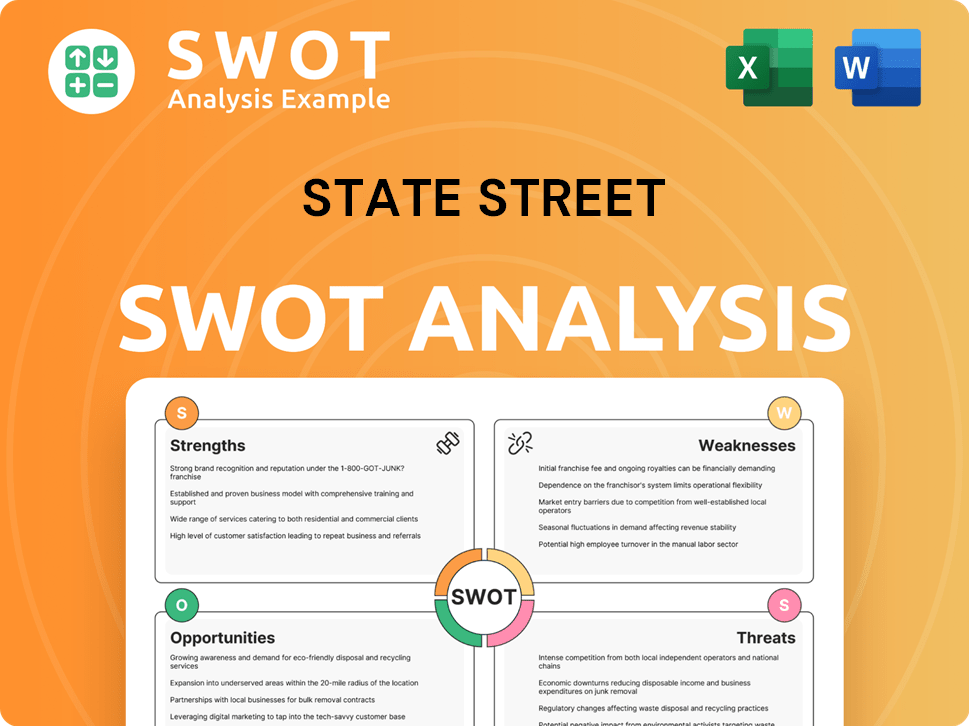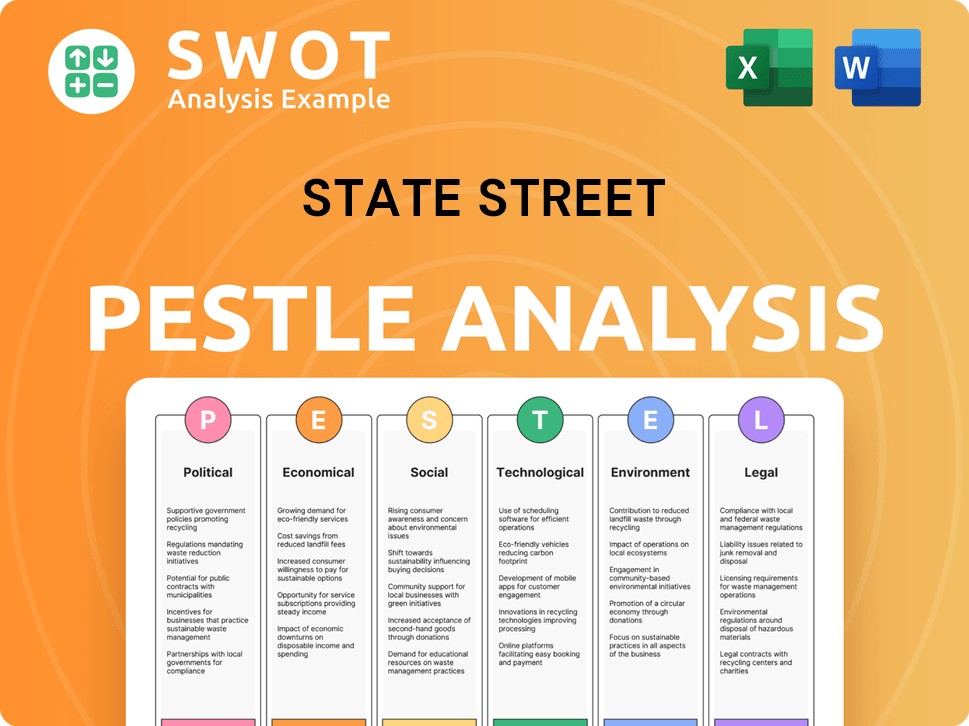State Street Bundle
Who Really Owns State Street Corporation?
Understanding the ownership of a financial powerhouse like State Street Corporation is crucial for anyone navigating the complexities of global markets. This exploration unveils the forces behind State Street's operations, from its historical roots as Union Bank in 1792 to its current status as a leading financial institution. Knowing the State Street SWOT Analysis can also help you understand the company's strengths and weaknesses.

State Street, a publicly traded company with the stock symbol STT, holds a significant position in the financial world, managing trillions in assets. This analysis explores the intricate details of State Street ownership, including its shareholders, key investors, and the influence of its board of directors. Discover the answers to questions like "Who owns State Street?" and gain insights into the company's strategic direction, governance, and overall impact on the financial landscape. Understanding the State Street ownership structure provides critical context for investors and analysts alike.
Who Founded State Street?
The story of State Street Corporation begins with the Union Bank, chartered in Boston, Massachusetts, on June 25, 1792. While the concept of a single 'founder' isn't directly applicable to this early institution, several prominent Boston merchants played key roles in its establishment. These individuals, including William Phillips, Jonathan Mason, and Samuel Eliot, were instrumental in the bank's formation. The initial capital for Union Bank was set at $800,000.
Later, in July 1891, the State Street Deposit & Trust Company was chartered in Boston, with an initial capital of $300,000. This entity was initiated by a group of directors and officers from the Third National Bank. Over time, the company evolved through mergers and name changes, eventually becoming the State Street we know today. The evolution reflects a long history of adapting to the changing financial landscape.
The company's evolution continued with significant mergers and strategic decisions. The merger with National Union Bank in 1925, and later with Second National Bank in 1955, were pivotal for growth. In 1960, the company was incorporated as State Street Boston Financial Corp., a one-bank holding company, and adopted its current name, State Street Bank and Trust Company. A key early decision was the establishment of custody services in 1924, which positioned the company as a leader in safeguarding financial assets.
State Street's origins can be traced back to the Union Bank, chartered in 1792. Prominent Boston merchants were key in its establishment.
The Union Bank started with an initial capital of $800,000. This provided a solid financial foundation.
The company went through several name changes, including State Street Deposit & Trust Company. The name changes reflect its growth and adaptation.
Mergers with National Union Bank and Second National Bank were crucial for expansion. These mergers expanded the company's asset base.
The establishment of custody services in 1924 was a transformative decision. This positioned the company as a leader in safeguarding assets.
In 1960, the company became State Street Boston Financial Corp. and adopted its current name. This marked a significant step in its corporate structure.
Understanding Revenue Streams & Business Model of State Street provides a deeper insight into how the company operates. State Street Corporation's early ownership was primarily in the hands of the initial investors and shareholders of the various banks and trust companies that formed the basis of the modern company. Over time, as the company grew and evolved, its ownership structure shifted to reflect its status as a publicly traded corporation. Today, the majority of State Street's shares are held by institutional investors. As of the latest data, the top institutional holders include major investment firms. The company's stock symbol is STT. The current CEO is Ron O'Hanley. The company's headquarters are located in Boston, Massachusetts. Knowing who owns State Street and the State Street ownership structure is key to understanding its operations.
State Street's history began with the Union Bank in 1792. The company evolved through mergers and strategic decisions.
- Early ownership was held by initial investors.
- The company's growth was fueled by mergers.
- Custody services established the company as a leader.
- Today, the majority of shares are held by institutional investors.
State Street SWOT Analysis
- Complete SWOT Breakdown
- Fully Customizable
- Editable in Excel & Word
- Professional Formatting
- Investor-Ready Format

How Has State Street’s Ownership Changed Over Time?
The ownership of State Street Corporation is primarily shaped by its status as a publicly traded entity on the New York Stock Exchange (NYSE: STT). This structure means that the ownership is widely dispersed among various shareholders, with institutional investors holding a significant portion of the shares. The evolution of its ownership reflects the growth and changes within the financial markets, with major players adjusting their stakes over time.
As of May 2025, the company's ownership structure includes a substantial number of institutional investors. These investors collectively hold a considerable number of shares, reflecting their confidence in the company's performance and future prospects. The continuous monitoring of these holdings through SEC filings provides insights into the dynamics of State Street's ownership and the influence of major shareholders.
| Shareholder | Shares Held (as of March 31, 2025) | Percentage of Shares |
|---|---|---|
| Vanguard Group Inc. | 37,124,659 | 12.87% |
| BlackRock, Inc. | 25,623,066 | 6.63% |
| State Street Corp. | 14,062,092 | 4.875% |
| Invesco Ltd. | 8,184,690 | N/A |
| Harris Associates L P | 7,689,735 | N/A |
| Geode Capital Management, LLC | 7,385,032 | N/A |
| Dodge & Cox | 7,331,559 | N/A |
| Fmr LLC | 6,530,856 | N/A |
| JPMorgan Chase & Co. | 6,329,644 | N/A |
The major shareholders, including Vanguard Group Inc. and BlackRock, Inc., hold substantial positions, indicating their significant influence over the company. The presence of these large institutional investors highlights the importance of asset management and investment firms in the overall ownership structure of State Street. The ongoing adjustments in these holdings reflect the dynamic nature of the financial markets and the strategic decisions of these key players. Understanding the State Street ownership structure is crucial for anyone looking to invest in or analyze the company.
State Street Corporation is a publicly traded company, with ownership mainly distributed among institutional investors.
- Vanguard and BlackRock are among the largest shareholders.
- Institutional investors hold a significant portion of the company's stock.
- The ownership structure is dynamic and subject to change.
- Understanding the major shareholders is important for investors.
State Street PESTLE Analysis
- Covers All 6 PESTLE Categories
- No Research Needed – Save Hours of Work
- Built by Experts, Trusted by Consultants
- Instant Download, Ready to Use
- 100% Editable, Fully Customizable

Who Sits on State Street’s Board?
The current board of directors at State Street Corporation is pivotal in overseeing the company's strategic direction and governance. All directors on the State Street Corporation's Board also serve on the board of its primary banking subsidiary, State Street Bank and Trust Company. Furthermore, the members of the Audit Committee, Compensation Committee, Governance Committee, and Board Risk Committee at the company also serve on the corresponding committees at the Bank. The upcoming 2025 annual meeting of shareholders, scheduled for May 14, 2025, will include the election of 11 directors, each for a one-year term.
State Street's commitment to sound governance is evident through its asset management division, State Street Global Advisors (SSGA). SSGA's proxy voting and engagement policy emphasizes effective board oversight, robust disclosure practices, and the protection of shareholder interests. They support annual elections for the entire board to ensure accountability. A fundamental principle of their voting strategy is 'one vote for one share,' aiming to align economic interests with proxy voting power.
| Board Member | Title | Other Affiliations |
|---|---|---|
| Ronald P. O’Hanley | Chairman and CEO | Director, Boston Medical Center |
| Karen L. Peetz | Lead Director | Former President, BNY Mellon |
| Edward B. Berton | Director | Former CFO, General Electric |
| William L. Young | Director | Former Chairman and CEO, Pall Corporation |
| Glenn A. Hutchins | Director | Co-founder, North Island |
| Jeffrey J. Brown | Director | Former Chairman and CEO, Ally Financial Inc. |
| Joanne M. Martin | Director | Former Executive Vice President, Johnson & Johnson |
| Robert L. Reynolds | Director | Former President and CEO, Putnam Investments |
| Robert F. Sharpe | Director | Former Vice Chairman, Deloitte LLP |
| Robert S. Sullivan | Director | Dean, University of Southern California Marshall School of Business |
| Robert L. Wilkens | Director | Former Executive Vice President, TIAA |
In March 2025, State Street Global Advisors updated its voting and engagement policy. These changes included removing specific indications of how it might vote on certain topics, such as those related to Diversity, Equity, and Inclusion (DE&I) and Task Force on Climate-related Financial Disclosures (TCFD) reporting. The firm eliminated all references to how it might vote against directors or on specific issues. A disclaimer was added, stating that SSGA 'does not seek to change or influence control of any portfolio company through engagement.' These adjustments followed an SEC rule change that imposed more stringent reporting requirements on engagements by passive investors. This approach aligns with the company's broader strategy, as discussed in the Marketing Strategy of State Street.
Understanding the board of directors and voting power is crucial for anyone interested in State Street ownership and State Street shareholders.
- The board oversees strategic direction and governance.
- SSGA's policy emphasizes effective board oversight and shareholder protection.
- Voting rights are generally based on 'one vote for one share.'
- Recent policy updates reflect changes in regulatory requirements.
State Street Business Model Canvas
- Complete 9-Block Business Model Canvas
- Effortlessly Communicate Your Business Strategy
- Investor-Ready BMC Format
- 100% Editable and Customizable
- Clear and Structured Layout

What Recent Changes Have Shaped State Street’s Ownership Landscape?
Over the past three to five years, State Street Corporation has continued to evolve, influencing its ownership and strategic direction. As of December 31, 2024, the company managed $4.7 trillion in assets and held $46.6 trillion under custody and administration. State Street's financial performance in 2024 included a revenue increase to US$13.00 billion and net income of US$2.687 billion.
A notable transaction was the agreement in February 2025 to acquire Mizuho Financial Group's global custody and related businesses outside Japan, encompassing approximately US$580 billion in assets under custody and US$24 billion under administration, with the deal expected to close in late 2025. This follows the dropped agreement in November 2022 to acquire Brown Brothers Harriman & Co.'s investor-services business, initially announced in September 2021, due to regulatory concerns.
| Metric | Value | Year |
|---|---|---|
| Assets Under Management | $4.7 trillion | December 31, 2024 |
| Assets Under Custody and Administration | $46.6 trillion | December 31, 2024 |
| Revenue | US$13.00 billion | 2024 |
| Net Income | US$2.687 billion | 2024 |
In February 2025, State Street also issued $750 million of depositary shares, representing a 1/100th ownership interest in its 6.450% Fixed Rate Reset Non-Cumulative Perpetual Preferred Stock, Series K. This issuance aimed to broaden its investor base. The trends in the market show an increased institutional ownership, with institutions maintaining high equity allocations, which impacts the State Street ownership structure. In May 2025, institutional investors increased their equity exposure by 0.9%.
Institutional investors have maintained a high percentage of their portfolios in equities. This trend directly impacts the ownership structure of companies like State Street. Examining State Street shareholders provides insight into the company's stability.
The acquisition of Mizuho Financial Group's global custody business is a strategic move. This expansion aims to increase State Street's assets under custody and administration. This growth is key to understanding Who owns State Street and its future direction.
State Street's revenue increased to US$13.00 billion in 2024. The net income reached US$2.687 billion during the same period. These financial results reflect the company's overall health and market position.
The issuance of $750 million in depositary shares in February 2025 aimed at expanding its investor base. This is one of the elements that define State Street ownership and its financial strategy. This is part of the State Street stock strategy.
State Street Porter's Five Forces Analysis
- Covers All 5 Competitive Forces in Detail
- Structured for Consultants, Students, and Founders
- 100% Editable in Microsoft Word & Excel
- Instant Digital Download – Use Immediately
- Compatible with Mac & PC – Fully Unlocked

Related Blogs
- What are Mission Vision & Core Values of State Street Company?
- What is Competitive Landscape of State Street Company?
- What is Growth Strategy and Future Prospects of State Street Company?
- How Does State Street Company Work?
- What is Sales and Marketing Strategy of State Street Company?
- What is Brief History of State Street Company?
- What is Customer Demographics and Target Market of State Street Company?
Disclaimer
All information, articles, and product details provided on this website are for general informational and educational purposes only. We do not claim any ownership over, nor do we intend to infringe upon, any trademarks, copyrights, logos, brand names, or other intellectual property mentioned or depicted on this site. Such intellectual property remains the property of its respective owners, and any references here are made solely for identification or informational purposes, without implying any affiliation, endorsement, or partnership.
We make no representations or warranties, express or implied, regarding the accuracy, completeness, or suitability of any content or products presented. Nothing on this website should be construed as legal, tax, investment, financial, medical, or other professional advice. In addition, no part of this site—including articles or product references—constitutes a solicitation, recommendation, endorsement, advertisement, or offer to buy or sell any securities, franchises, or other financial instruments, particularly in jurisdictions where such activity would be unlawful.
All content is of a general nature and may not address the specific circumstances of any individual or entity. It is not a substitute for professional advice or services. Any actions you take based on the information provided here are strictly at your own risk. You accept full responsibility for any decisions or outcomes arising from your use of this website and agree to release us from any liability in connection with your use of, or reliance upon, the content or products found herein.